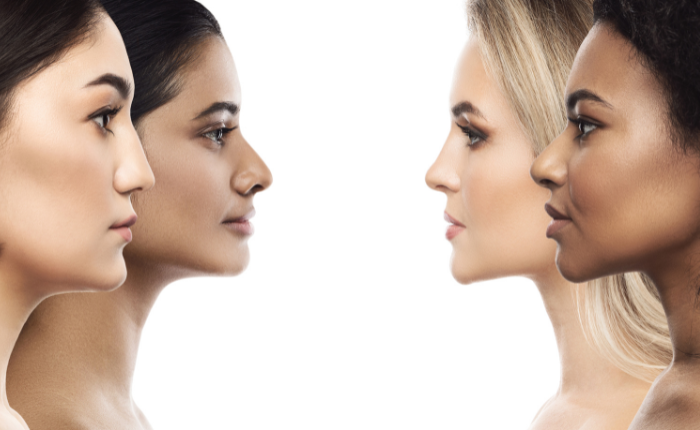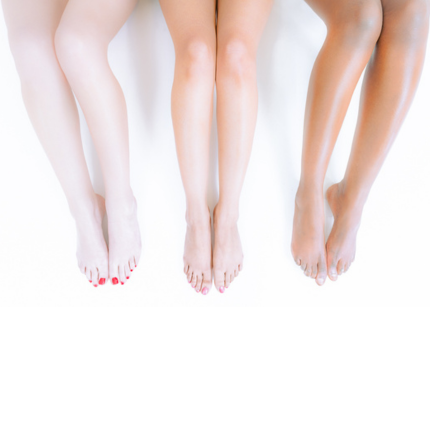The Fitzpatrick scale is crucial for determining the appropriate laser hair removal procedure for different skin types. Developed by Dr. Thomas B. Fitzpatrick in 1975, this scale classifies skin types based on their reaction to ultraviolet (UV) radiation and susceptibility to skin cancer. It is widely used in dermatology to evaluate skin’s response to various treatments, including laser hair removal.

Fitzpatrick Skin Types
Type I
Skin Color: Very fair, white skin
Eye Color: Blue, green
Hair Color: Red or light hair
Sun Reaction: Always burns, never tans
Characteristics: Very sensitive skin, extremely high risk of UV radiation damage and skin cancer
Type II
Skin Color: Fair, white skin
Eye Color: Blue, green, hazel
Hair Color: Light to light brown hair
Sun Reaction: Usually burns, hard to tan
Characteristics: High risk of UV damage and skin cancer
Type III
Skin Color: Light brown, creamy skin
Eye Color: Light brown to dark brown
Hair Color: Dark blonde to brown
Sun Reaction: Sometimes burns, gradually tans
Characteristics: Moderate risk of UV radiation damage and skin cancer
Type IV
Skin Color: Brown, medium brown skin
Eye Color: Dark brown
Hair Color: Brown to black
Sun Reaction: Rarely burns, easily tans
Characteristics: Less risk of UV damage and skin cancer than types I-III
Type V
Skin Color: Dark brown skin
Eye Color: Dark brown to black
Hair Color: Black
Sun Reaction: Very rarely burns, easily and intensely tans
Characteristics: Low risk of UV radiation damage, but still a risk of skin cancer
Type VI
Skin Color: Very dark brown to black skin
Eye Color: Black
Hair Color: Black
Sun Reaction: Never burns, tans very easily
Characteristics: Lowest risk of UV damage and skin cancer, but still not out of the question
Importance of the Fitzpatrick Scale in Laser Hair Removal
Laser Selection Based on Skin Type
Types I-III: These skin types are suitable for alexandrite lasers (755 nm), which are effective on fair skin and lighter hair. The alexandrite laser targets melanin in the hair, providing efficient hair removal with minimal risk of damage to the lighter skin.
Types IV-VI: For darker skin types, diode lasers (800-810 nm) or Nd
lasers (1064 nm) are preferred. These lasers penetrate deeper into the skin and have a lower affinity for melanin in the epidermis, reducing the risk of burns and pigmentation issues.


Effectiveness and Safety
The Fitzpatrick scale helps in assessing the risk of side effects and optimizing treatment parameters. Here’s how:
Preventing Burns and Hyperpigmentation: Darker skin types absorb more laser energy, increasing the risk of burns and hyperpigmentation. Using the appropriate laser wavelength helps in targeting the hair follicle without damaging the surrounding skin.
Optimizing Laser Settings: For lighter skin types, higher energy settings can be used safely to maximize efficacy. For darker skin types, lower energy settings and longer wavelengths are safer and still effective.
Customized Treatment Plans
Understanding a patient’s Fitzpatrick skin type allows dermatologists and cosmetologists to customize treatment plans, ensuring the most effective and safe laser hair removal process. This includes:
Selecting the Right Laser Type: Matching the laser type and wavelength to the patient’s skin type.
Adjusting Energy Levels: Fine-tuning the laser settings to balance efficacy and safety.
Scheduling Sessions Appropriately: Planning the number and frequency of sessions based on the patient’s skin type and hair growth patterns.
The Fitzpatrick scale is an essential tool in laser hair removal, guiding the selection of the appropriate laser type and settings for each skin type. By considering the Fitzpatrick skin type, dermatologists can ensure safe, effective, and personalized treatments, minimizing the risk of side effects and optimizing hair removal results.






